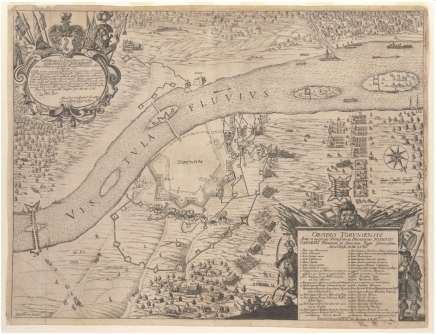The Hutten-Czapski Museum
ul. Piłsudskiego 12, 31-109 Kraków- Monday: closed
- tue : 10.00-18.00
- wednesday-sunday: 10.00-16.00
Information and reservations on weekdays 9 a.m.- 4 p.m.
The Director of the National Museum in Krakow
Deputy Director for Programme Activity
Deputy Director for Strategy and Communications
Deputy director for the Management
Chief Accountant
Chief Cataloguer of the National Museum in Krakow
Chief Conservator

Near the borders of Poland in the province of Lesser Poland there stands a high and rocky crag of the Tatra mountains […] whence the river Vistula flows from its source and meanders through the centre of the Crown Kingdom of Poland northwards to the very city of Gdańsk, where its fresh waters into the salt water of the Baltic Sea flow and intermingle. Indeed, this one among all others in the Kingdom of Poland is known as the Head of All Rivers. These words about the Vistula and a woodcut showing a landscape with Barania Góra (Ram Mountain), where the sources of the Vistula are located, open an exhibition dedicated to this queen of Polish rivers and portrayals of it in historic books, maps, and plans. A characterisation of the Vistula and an engraving of it were included in a 1703 edition of Hieronim Morsztyn’s work “Antypasty Małżeńskie (Matrimonial Appetisers)”, a collection of three amorous tales first published in 1650.
The exhibition presents 39 historic books and 34 maps, plans, and atlases dating from the mid-16th to the late 19th centuries. In geographical, historical, legal, and economic works, as well as in literary and journalistic publications, we find fragments, chapters, paragraphs, and verses concerning the Vistula. These are often accompanied by illustrations of the course of the river in plans and maps, as well as by views of the river itself or of the landscape of its banks and plans and panoramas of the towns and cities located along it. These are in a variety of techniques including woodcuts, copper plate engravings, lithographs, and drawings.
Among the works presented, the 1643 edition of Sebastian Klonowic’s descriptive poem “Flis (River rafting)” reveals the intricacies of river-borne trade good transport along the Vistula, illustrating the difficult work of the raftsmen and the beauty of the sometimes ominous river. With a literary aside to the Vistula – Flow, dear Vistula mine, down to the seaport, and save by any means you may the Kingdom of Poland – the poet Mikołaj Rej begins one of the verses in his “Zwierzyniec (The Bestiary)”, published in 1574. Jan Kochanowski in turn dedicates a verse to a bridge built over the Vistula in Warsaw in a work published in 1573, while a poetic description of the river from its source to its mouth is given by the German humanist Conrad Celtes in a work published in 1582.
Views of Kraków, Warsaw, Toruń, and Gdańsk showing the Vistula make reference to a variety of events intertwined with the history of Poland, from the times of king Sigismund August through the period of the Swedish invasion of 1655-1660 known as the Deluge to the War of Polish Succession in the early 18th century. A set of spectacular multi-page Warsaw city plans dating from 1822 and 1838 portray the Vistula as it was in the early 19th century, which as a result of the Partitions of Poland then stretched across the domains of three separate national entities.
From the Middle Ages to the end of the 18th century, the Vistula was the primary avenue of transport in Poland, a backbone uniting a vast collection of lands diverse in social and economic terms. This situation was changed by the Partitions of 1772, 1793, and 1795, which brought the lands of the former Republic of Poland under the control of Prussia, Russia, and Austria, three quite different states with different political and economic priorities. In spite of this, the Vistula and its tributaries as a single riverine system remained inextricably linked with the Polish lands and continued to play a significant role in the history of the Polish nation, a role which was at once economic, social, and cultural.
Curator:
Iwona Długopolska
Autor: Iwona Długopolska